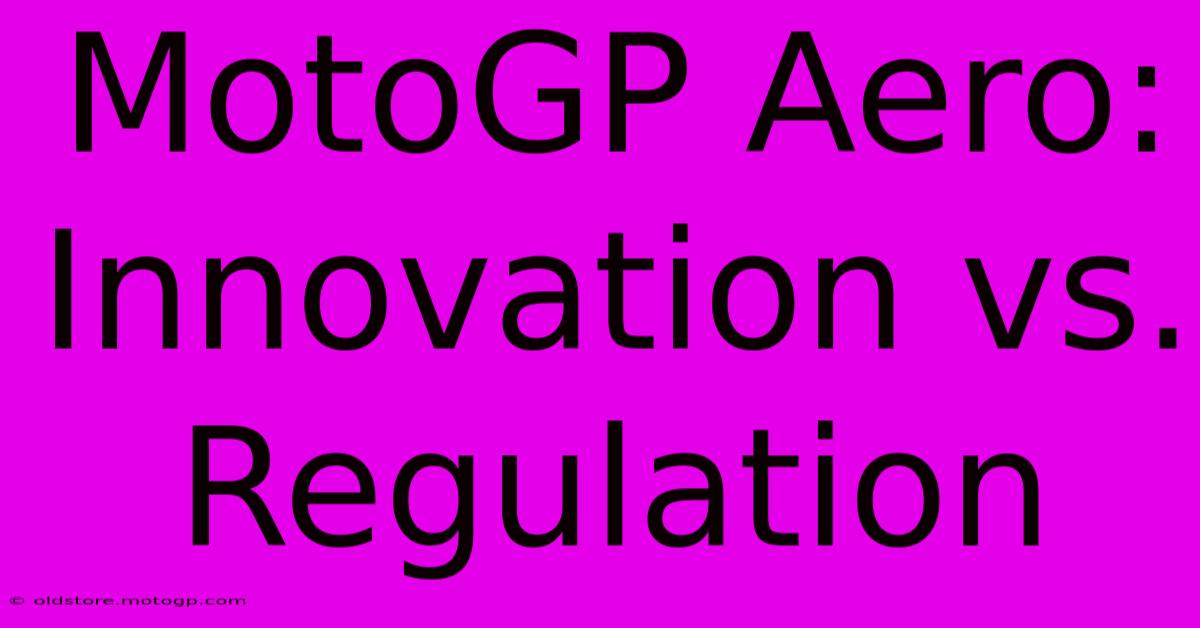MotoGP Aero: Innovation Vs. Regulation

Table of Contents
MotoGP Aero: Innovation vs. Regulation – A Balancing Act
MotoGP, the pinnacle of motorcycle road racing, is a constant battleground of innovation. Nowhere is this more apparent than in the aerodynamic development of the machines. Teams relentlessly push the boundaries of what's possible, striving for that crucial edge in speed and stability. However, this pursuit of performance constantly clashes with the need for regulation, ensuring fairness, safety, and preventing an arms race that could make the sport prohibitively expensive and potentially dangerous.
The Aerodynamic Arms Race: A History of Innovation
The history of MotoGP aerodynamics is a fascinating journey of constant evolution. From the relatively simple fairings of the past, we've progressed to incredibly sophisticated wings, winglets, and other aerodynamic devices. These advancements aren't just about aesthetics; they drastically impact performance.
Key Aerodynamic Advancements:
- Early Fairings: Initially focused on streamlining and reducing drag.
- Underbody Aerodynamics: The discovery of the importance of airflow under the motorcycle led to significant gains in stability and cornering speed.
- Winglets and Wings: These additions generate downforce, increasing grip at high speeds and improving stability through corners. This has been a particularly significant area of innovation in recent years.
- Streamlining and Fairing Design: Constant refinement of fairing shapes and materials reduces drag and improves airflow management.
- Computational Fluid Dynamics (CFD): The use of sophisticated computer simulations has revolutionized aerodynamic design, allowing engineers to test and optimize designs virtually before physical testing.
These innovations have undeniably made MotoGP bikes faster and more capable. However, the ever-increasing sophistication of aerodynamic aids has led to concerns about safety and the escalating costs associated with development.
The Role of Regulation in MotoGP
The governing body, Dorna Sports, plays a crucial role in managing this technological arms race through strict regulations. These regulations aim to:
- Ensure Fair Competition: Prevent teams with larger budgets from gaining an insurmountable advantage.
- Maintain Safety: Limit the potential risks associated with excessive downforce or unstable aerodynamic configurations.
- Control Costs: Prevent an uncontrolled escalation in development costs that could force smaller teams out of the sport.
Types of Aerodynamic Regulations:
- Winglet Restrictions: The size, shape, and placement of winglets and wings are strictly controlled. This often involves limitations on the overall surface area and specific dimensional requirements.
- Fairing Specifications: Certain aspects of the fairing design, such as materials and dimensions, are also subject to regulation.
- Testing Restrictions: Limits on wind tunnel testing and computational fluid dynamics (CFD) simulations help to level the playing field.
The Ongoing Balancing Act
The relationship between innovation and regulation in MotoGP aerodynamics remains a delicate balancing act. While Dorna Sports needs to control costs and safety, they also understand the importance of allowing teams to push the boundaries of technological advancement. This dynamic creates a constant tension, with teams constantly seeking loopholes and innovations within the existing regulations, while Dorna continually adapts its rules to maintain fairness and safety.
The future of MotoGP aerodynamics is likely to continue this trend of incremental improvement within a strictly defined regulatory framework. We can anticipate further refinements in fairing design, the development of more sophisticated computational models, and potentially new areas of aerodynamic exploration as technology evolves. The challenge for Dorna will be to strike the right balance, fostering innovation while maintaining a level playing field and ensuring the safety of the riders.
Keywords: MotoGP, Aerodynamics, Wings, Winglets, Downforce, Regulation, Innovation, Safety, Competition, Fair Play, Dorna Sports, CFD, Wind Tunnel, Fairing Design, Technological Advancement, Motorcycle Racing.

Thank you for visiting our website wich cover about MotoGP Aero: Innovation Vs. Regulation. We hope the information provided has been useful to you. Feel free to contact us if you have any questions or need further assistance. See you next time and dont miss to bookmark.
Featured Posts
-
Cota Qualifying F1s Battle For Pole Position
Feb 18, 2025
-
Cota Parking Lot T The Best Parking Spot At Cota
Feb 18, 2025
-
Moto Gp Crash Rider Interviews
Feb 18, 2025
-
Moto Gp Aero Innovation Vs Regulation
Feb 18, 2025
-
Circuit Race Regulations Know The Rules
Feb 18, 2025
